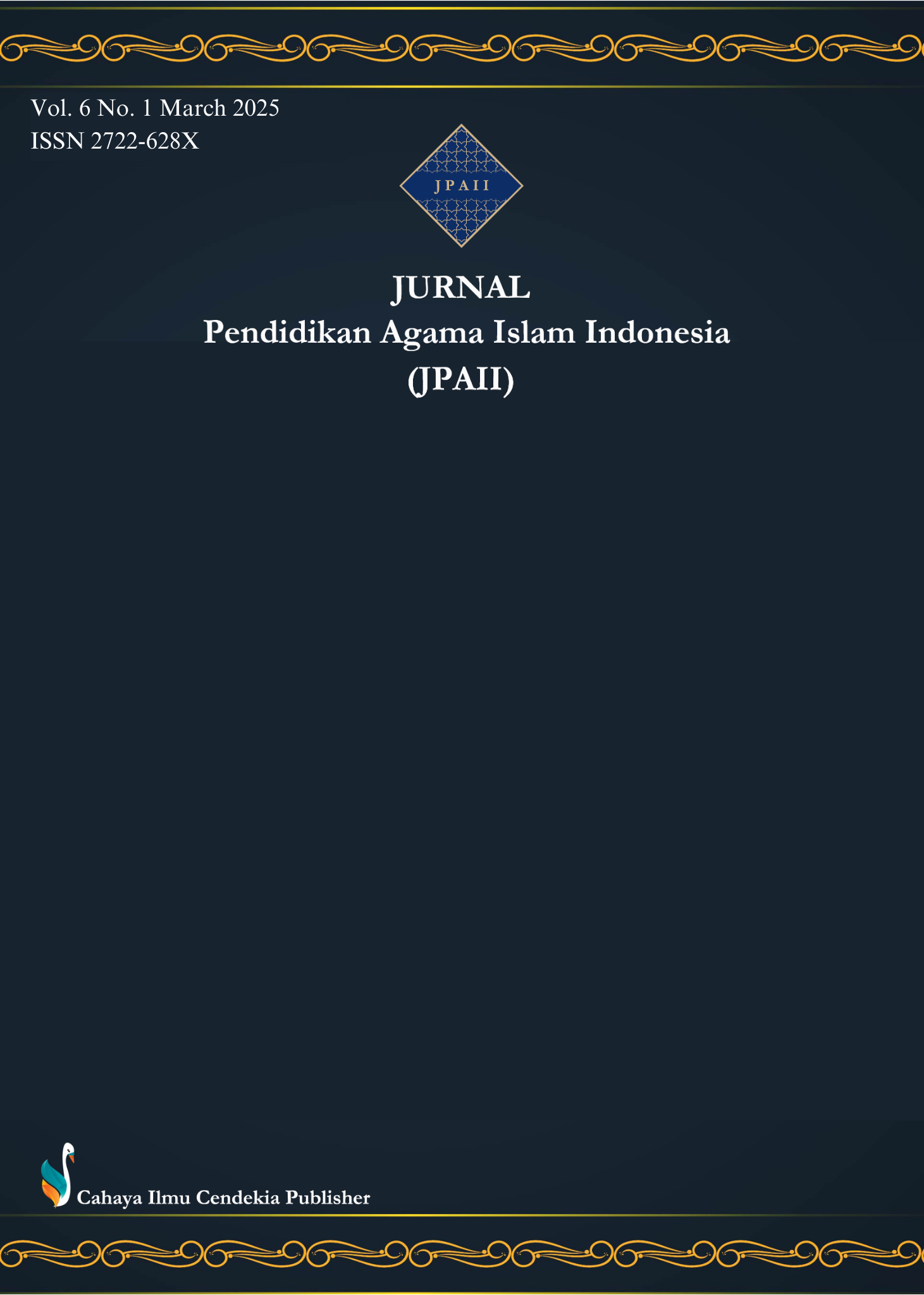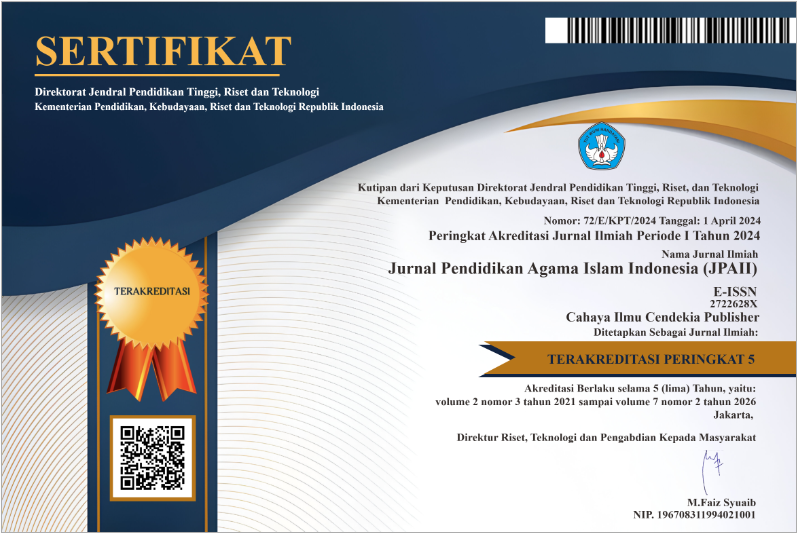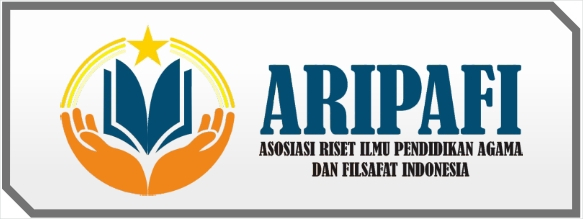The Influence of Islamic Religious Education Learning in Forming Students' Character and Noble Morals
Abstract
Purpose of the study: The purpose of this study is to see whether there is an influence of Islamic religious education learning on the morals of students at Widya Yahya Gading Rejo Vocational School, Pringsewu Regency.
Methodology: The approach used is a quantitative approach. Data collection was carried out using a survey method with a questionnaire as an instrument to obtain X and Y data and analyzed using the product moment correlation analysis technique and tested with the t-test to determine the real level.
Main Findings: The results of the correlation analysis showed an rxy value of 0.468, which is included in the moderate relationship category (0.400 – 0.599) and significant. The t-test test produced a t-count value of 4.620, which is greater than ttable (1.992) at a significance level of 0.05 with a degree of freedom (dk) of 78. This confirms the hypothesis that Islamic Religious Education learning has a positive influence on students' morals. The determination coefficient of 21.9% indicates that Islamic Religious Education learning affects students' morals by 21.9%, while 78.1% is influenced by other variables.
Novelty/Originality of this study: This study provides innovation by specifically examining the influence of Islamic Religious Education learning on students' morals in the vocational school environment, which is still rarely done in the Pringsewu Regency area, and offers quantitative data as a basis for developing a religion-based education strategy.
References
C. Pramana, D. Chamidah, S. Suyatno, F. Renadi, and S. Syaharuddin, “Strategies to Improved Education Quality in Indonesia: A Review.,” Turkish Online J. Qual. Inq., vol. 12, no. 3, pp. 1977–1994, 2021.
A. Barranca-Enríquez and T. Romo-González, “Your health is in your mouth: A comprehensive view to promote general wellness,” Front. Oral Heal., vol. 3, no. September, pp. 1–14, 2022, doi: 10.3389/froh.2022.971223.
I. W. Ningsih, “The Implementation of Character Education Values in Indonesia in Realizing The Ideal Human Being ( Insan Kamil ),” Qiro’ah J. Pendidik. Agama Islam, vol. 14, no. 2, pp. 168–178, 2024.
T. K. Narbaeva and A. Musurmanova, “Priority Areas Of Spiritual, Moral And Physical Education Of Youth In The Family,” İlköğretim Online, vol. 20, no. 3, pp. 1648–1656, 2021, doi: 10.17051/ilkonline.2021.03.187.
S. Sadri, E. Emawati, and H. Hully, “Integration of Pancasila Student Profile Values in Islamic Religious Education (PAI) Learning at SMA Negeri 1 Gerung,” Int. J. Educ. Narrat., vol. 2, no. 1, pp. 146–158, 2024, doi: 10.70177/ijen.v2i1.719.
H. Hasbiyallah and M. N. Ihsan, “Internalization of Education Character Based on the Five Souls of Modern Islamic Boarding School Al-Ihsan Baleendah,” Int. J. Adv. Sci. Educ. Relig., vol. 4, no. 2, pp. 126–138, 2021, doi: 10.33648/ijoaser.v4i2.151.
M. S. A. Huda, S. Sariman, and M. Khasanudin, “Strategy of Islamic Religious Education Teachers in Improving The Islamic Character of Students,” Scaffolding J. Pendidik. Islam dan Multikulturalisme, vol. 4, no. 2, pp. 58–70, 2022.
Amrin, S. . Asiah, M. M. Al-Qosimi, A. I. Imamah, M. U. Rochmawati, and N. Shofita, “New Normal and Islamic Education: Islamic Religious Education Strategy on Educational Institutions in Indonesia,” J. Pendidik. dan Konseling, vol. 4, no. 3, pp. 120–129, 2022.
M. R. Nasucha, K. Khozin, and I. Thoifah, “Synergizing Islamic Religious Education and Scientific Learning in the 21st Century: A Systematic Review of Literature,” J. Pendidik. Agama Islam (Journal Islam. Educ. Stud., vol. 11, no. 1, pp. 109–130, 2023, doi: 10.15642/jpai.2023.11.1.109-130.
A. Achadah, W. Wahidmurni, and A. F. Yasin, “Internalization of Character Education Values in Shaping Elementary School Students’ Religious Behavior,” AL-ISHLAH J. Pendidik., vol. 14, no. 4, pp. 4723–4734, 2022, doi: 10.35445/alishlah.v14i4.2509.
A. H. OK, M. Al-Farabi, and F. Firmansyah, “Internalization of Multicultural Islamic Education Values In High School Students,” Munaddhomah J. Manaj. Pendidik. Islam, vol. 3, no. 3, pp. 221–228, 2023, doi: 10.31538/munaddhomah.v3i3.265.
A. A. Prasetia, “Implementation of Value Education in Islamic Religious Education,” J. Kaji. Pendidik. dan Psikol., vol. 2, no. 1, pp. 69–75, 2024.
N. D. Tsoraya, O. Primalaini, and Masduki Asbari, “The Role of Islamic Religious Education on the Development Youths’ Attitudes,” J. Inf. Syst. Manag., vol. 01, no. 01, pp. 12–18, 2022, https://jisma.org/index.php/jisma/article/view/3
N. Komariah and I. Nihayah, “Improving the personality character of students through learning Islamic religious education,” At-Tadzkir Islam. Educ. J., vol. 2, no. 1, pp. 65–77, 2023.
M. Rodiyah, S. Suhermanto, and A. Fawait, “the Importance of Islamic Religious Education and Moral Education in Building the Character of Primary School Children,” in Proceeding of International Conference on Education, Society and Humanity, 2023, p. 2023.
R. Mulyana, “Religious moderation in Islamic religious educatiotextbook and implementation in Indonesia,” HTS Teol. Stud. / Theol. Stud., vol. 79, no. 1, pp. 1–8, 2023, doi: 10.4102/HTS.V79I1.8592.
B. W. K. Guna, S. E. Yuwantiningrum, F. Firmansyah, M. D. Aminudin, and A. Aslan, “Building Morality and Ethics Through Islamic Religious Education in Schools,” IJGIE (International J. Grad. Islam. Educ., vol. 5, no. 1, pp. 14–24, 2024, doi: 10.37567/ijgie.v5i1.2685.
Y. K. Saputra, M. Dylan, and D. Carmelo, “Fostering Islamic Morality through Tahfidz Learning: Islamic Law,” Int. J. Educ. Narrat., vol. 1, no. 2, pp. 49–62, 2023, doi: 10.55849/ijen.v1i2.305.
I. M. P. Astakoni, N. L. P. Sariani, A. Yulistiyono, I. N. T. Sutaguna, and N. M. S. Utami, “Spiritual Leadership, Workplace Spirituality and Organizational Commitment; Individual Spirituality as Moderating Variable,” Italienisch, vol. 12, no. 2, pp. 620–631, 2022.
M. Madum and D. Daimah, “Character Building Through Islamic Education: Nurturing the Indonesian Nation’S Values,” LISAN AL-HAL J. Pengemb. Pemikir. dan Kebud., vol. 18, no. 1, pp. 59–71, 2024, doi: 10.35316/lisanalhal.v18i1.59-71.
A. P. Rahayu and Y. Dong, “The Relationship of Extracurricular Activities with Students’ Character Education and Influencing Factors: A Systematic Literature Review,” AL-ISHLAH J. Pendidik., vol. 15, no. 1, pp. 459–474, 2023, doi: 10.35445/alishlah.v15i1.2968.
M. A. F. Sanjani, “The Impact of School Principals on Graduate Quality Through Character Education Initiatives,” J. Educ. Manag. Res., vol. 3, no. 1, pp. 30–46, 2024, doi: 10.61987/jemr.v3i1.347.
X. Wei and B. Shen, “Effects of Two Face Regulatory Foci About Ethical Fashion Consumption in a Confucian Context: Face Regulatory Foci and EFC: X. Wei, B. Shen,” J. Bus. Ethics, vol. 196, no. 4, pp. 807–825, 2024, doi: 10.1007/s10551-024-05870-1.
H. Mulang and A. H. P. K. Putra, “Exploring the Implementation of Ethical and Spiritual Values in High School Education: A Case Study in Makassar, Indonesia,” Golden Ratio Soc. Sci. Educ., vol. 3, no. 1, pp. 01–13, 2023, doi: 10.52970/grsse.v3i1.105.
A. Tohri, A. Rasyad, M. Sururuddin, and L. M. Istiqlal, “The Urgency of Sasak Local Wisdom-Based Character Education for Elementary School in East Lombok, Indonesia.,” Int. J. Eval. Res. Educ., vol. 11, no. 1, pp. 333–344, 2022.
N. Taja, E. S. Nurdin, A. Kosasih, E. Suresman, and T. Supriyadi, “Character education in the pandemic era: A religious ethical learning model through Islamic education,” Int. J. Learn. Teach. Educ. Res., vol. 20, no. 11, pp. 132–153, 2021, doi: 10.26803/ijlter.20.11.8.
N. Komariah and I. Nihayah, “Improving The Personality Character of Students Through Learning Islamic Religious Education,” At-tadzkir Islam. Educ. J., vol. 2, no. 1, pp. 65–77, 2023, doi: 10.59373/attadzkir.v2i1.15.
Asrori Asrori and T. Stiawan, “The concept of learning Islamic education based on multicultural in establishing religious moderation,” Annu. Conf. Islam. Relig. Educ., vol. 2, no. 1, pp. 819–831, 2022, [Online]. Available: http://acied.pp-paiindonesia.org/index.php/acied%7C819
Umiarso and Muhammad Qorib, “The Practice of Religious Moderation Based on Theo-anthropocentric in Indonesian Islamic Boarding Schools: A Phenomenological Study,” J. Iqra’ Kaji. Ilmu Pendidik., vol. 7, no. 2, pp. 183–193, 2022, doi: 10.25217/ji.v7i2.2629.
M. Masturin, “Development of Islamic Religious Education Materials Based on Religious Moderation in Forming Student Character,” Munaddhomah J. Manaj. Pendidik. Islam, vol. 3, no. 4, pp. 246–355, 2023, doi: 10.31538/munaddhomah.v3i4.310.
M. Komalasari and A. B. Yakubu, “Implementation of Student Character Formation Through Islamic Religious Education,” At-tadzkir Islam. Educ. J., vol. 2, no. 1, pp. 52–64, 2023, doi: 10.59373/attadzkir.v2i1.16.
S. S. B. Surbakti, R. Harahap, and U. Hasanah, “Future perspectives on the islamic personality model: Integrating spiritual, moral, intellectual, social, personal, and behavioral dimensions for holistic development,” J. Islam. Stud., vol. 1, no. 1, pp. 17–35, 2024, doi: 10.35335/7adqms82.
I. Mujahid, “Islamic orthodoxy-based character education: creating moderate Muslim in a modern pesantren in Indonesia,” Indones. J. Islam Muslim Soc., vol. 11, no. 2, pp. 185–212, 2021, doi: 10.18326/ijims.v11i2.185-212.
M. Abu Bakar, K. A. Umroh, and F. Hameed, “Improving Quality Islamic Education for Today’s Generation,” At-tadzkir Islam. Educ. J., vol. 2, no. 2, pp. 118–128, 2023, doi: 10.59373/attadzkir.v2i2.42.
U. Khasanah, “Islamic Education as a Foundation of Character : a Case Study of the Formation of Noble Morals in Students,” J. Islam. Educ., vol. 8, no. 2, pp. 294–309, 2023.
A. Ghanad, “An Overview of Quantitative Research Methods,” Int. J. Multidiscip. Res. Anal., vol. 06, no. 08, pp. 3794–3803, 2023, doi: 10.47191/ijmra/v6-i8-52.
J. Maksimović and J. Evtimov, “Positivism and post-positivism as the basis of quantitative research in pedagogy,” Res. Pedagog., vol. 13, no. 1, pp. 208–218, 2023, doi: 10.5937/istrped2301208m.
A. Kurniawan, U. S. Hidayatun, Tasrim, A. Jayanti, E. Septyarini, and T. D. Sudibyo, “Enhancing Customer Loyalty: the Role of Service Quality in Customer Satisfaction,” J. Lifestyle SDG’S Rev., vol. 5, no. 2, pp. 1–25, 2025, doi: 10.47172/2965-730X.SDGsReview.v5.n02.pe04412.
S. Hartini, E. Alie, and J. March, “The Relationship Between Authoritarian Parenting and Aggressive Behavior of Adolescents in Nagari Bungo Tanjung,” World Psychol., vol. 1, no. 2, pp. 18–26, 2022, doi: 10.55849/wp.v1i2.98.
I. Kusmaryono, D. Wijayanti, and H. R. Maharani, “Number of Response Options, Reliability, Validity, and Potential Bias in the Use of the Likert Scale Education and Social Science Research: A Literature Review,” Int. J. Educ. Methodol., vol. 8, no. 4, pp. 625–637, 2022, doi: 10.12973/ijem.8.4.625.
S. Khoiriyah, V. Wiliyanti, I. Gunawan, I. Negeri Raden Intan Lampung, J. Letkol Endro Suratmin, and B. Lampung, “The Influence of The STEM Learning Approach on Students Communication and Collaboration Abilities on Elasticity Materials,” J. Penelit. Pembelajaran Fis., vol. 15, no. 3, pp. 263–271, 2024, doi: 10.26877/jp2f.v15i3.18724.
S. W. Jarantow, E. D. Pisors, and M. L. Chiu, “Introduction to the Use of Linear and Nonlinear Regression Analysis in Quantitative Biological Assays,” Curr. Protoc., vol. 3, no. 6, pp. 1–56, 2023, doi: 10.1002/cpz1.801.
Copyright (c) 2025 Nova Mutiara Dewi, Nahidah J. Abdulhassan, Hafiz Abdul Quddoos

This work is licensed under a Creative Commons Attribution 4.0 International License.
Authors who publish with this journal agree to the following terms:
- Authors retain copyright and acknowledge that the Jurnal Pendidikan Agama Islam Indonesia (JPAII) is the first publisher licensed under a Creative Commons Attribution 4.0 International License.
- Authors are able to enter into separate, additional contractual arrangements for the non-exclusive distribution of the journal's published version of the work (e.g., post it to an institutional repository or publish it in a book), with an acknowledgment of its initial publication in this journal.
- Authors are permitted and encouraged to post their work online (e.g., in institutional repositories or on their website) prior to and during the submission process, as it can lead to productive exchanges and earlier and greater citation of published work.







.png)
.png)





















